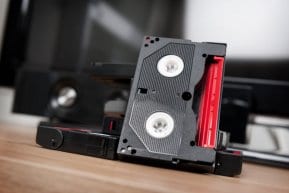We digitize three different varieties of 8mm video tapes at EverPresent: Video8, Hi8 tapes, and Digital8 tapes. All of these 8mm tapes can be converted to DVD or a digitally downloadable file. Here are a few facts that you may not know about this video format:
- 8mm tapes are about a quarter of the size of VHS tapes, their larger cousins. Clients have confused 8mm cassettes with audio cassettes before, given their similar dimensions. However, 8mm tapes are thicker than audio cassettes.
- The first 8mm commercially successful camera for this format was released by Sony in 1985.
- Like VHS tapes, 8mm tapes can be compatible with NTSC or PAL/SECAM systems.
- Video8 was the first 8mm tape format, as opposed to the more recent iterations, it is entirely analog.
- Hi8 tapes followed Video8 and were somewhat higher quality. Digital information can be written onto the tape with certain equipment, but it is largely an analog format as well.
- Digital8 tapes are the most recent 8mm tape iteration. As the name suggests, the information stored on these tapes is digital. These tapes generally transfer to DVD with very high quality.
- All three of these 8mm tape formats look remarkably similar to one another. The main differences between the formats is the way the video is encoded onto the tape.
- The maximum run-time for the tape is 120 minutes
- 8mm tapes generally transfer to digital in high quality. Some older tapes show signs of deterioration during playback.
- It is still possible to find the equipment needed to record on 8mm tapes. However, the format is rapidly being replaced by digital camcorders and smart phones that record directly into digital files.
If you have any questions about your 8mm tapes (or an audio tape that looks suspicious after reading this), feel free to give us a call or shoot us an email and we can answer any questions you have and walk you through the digital transfer process.

